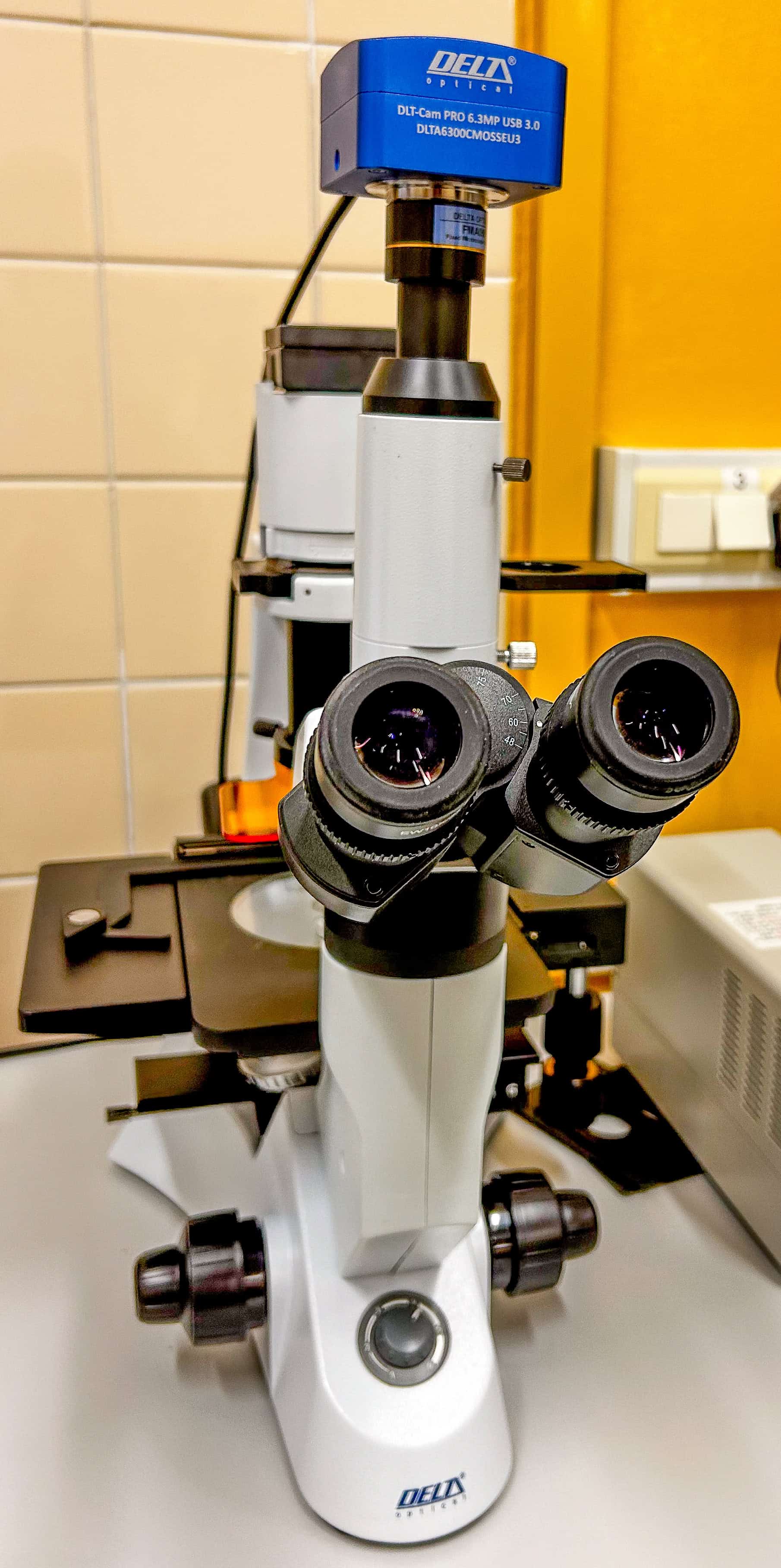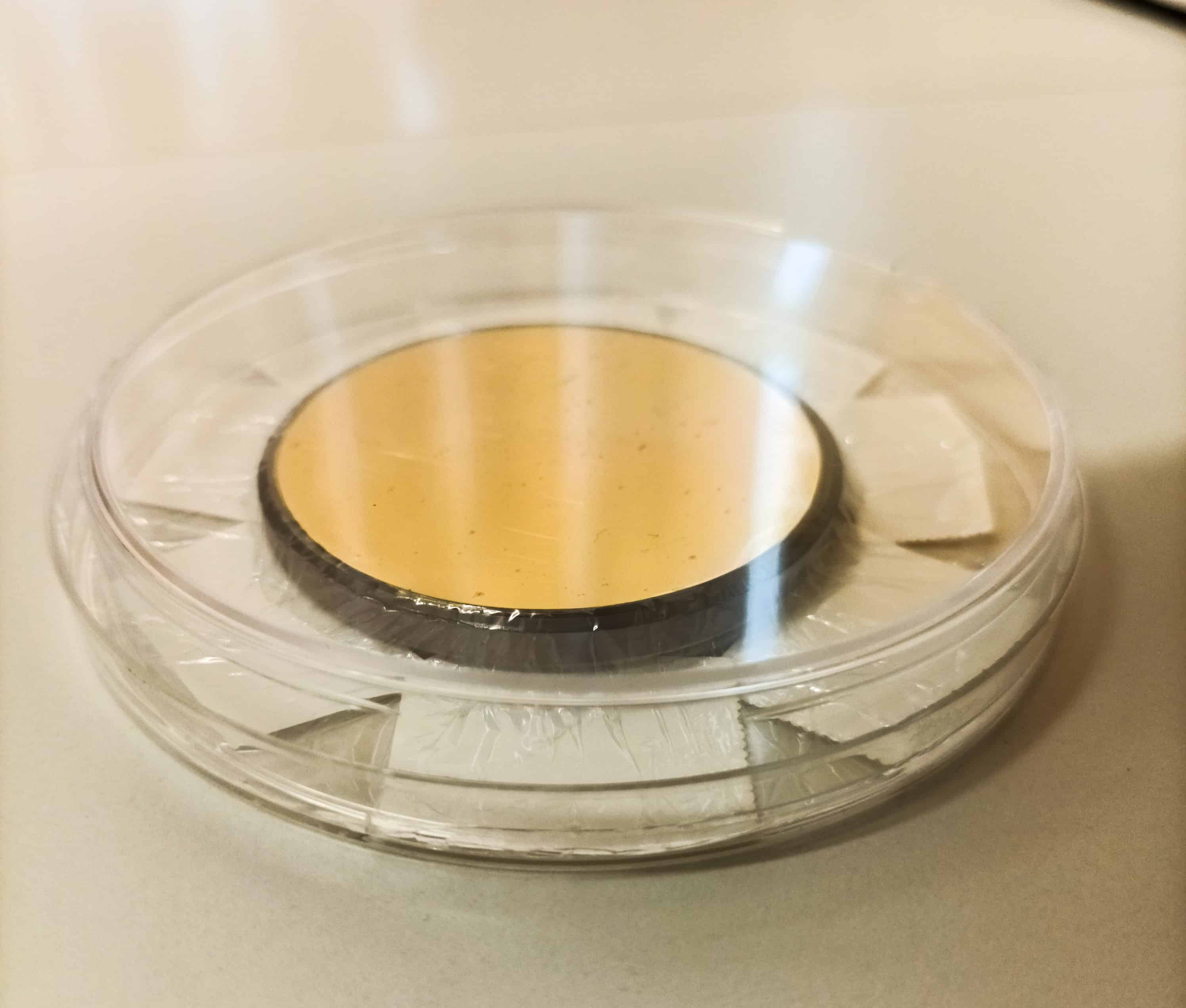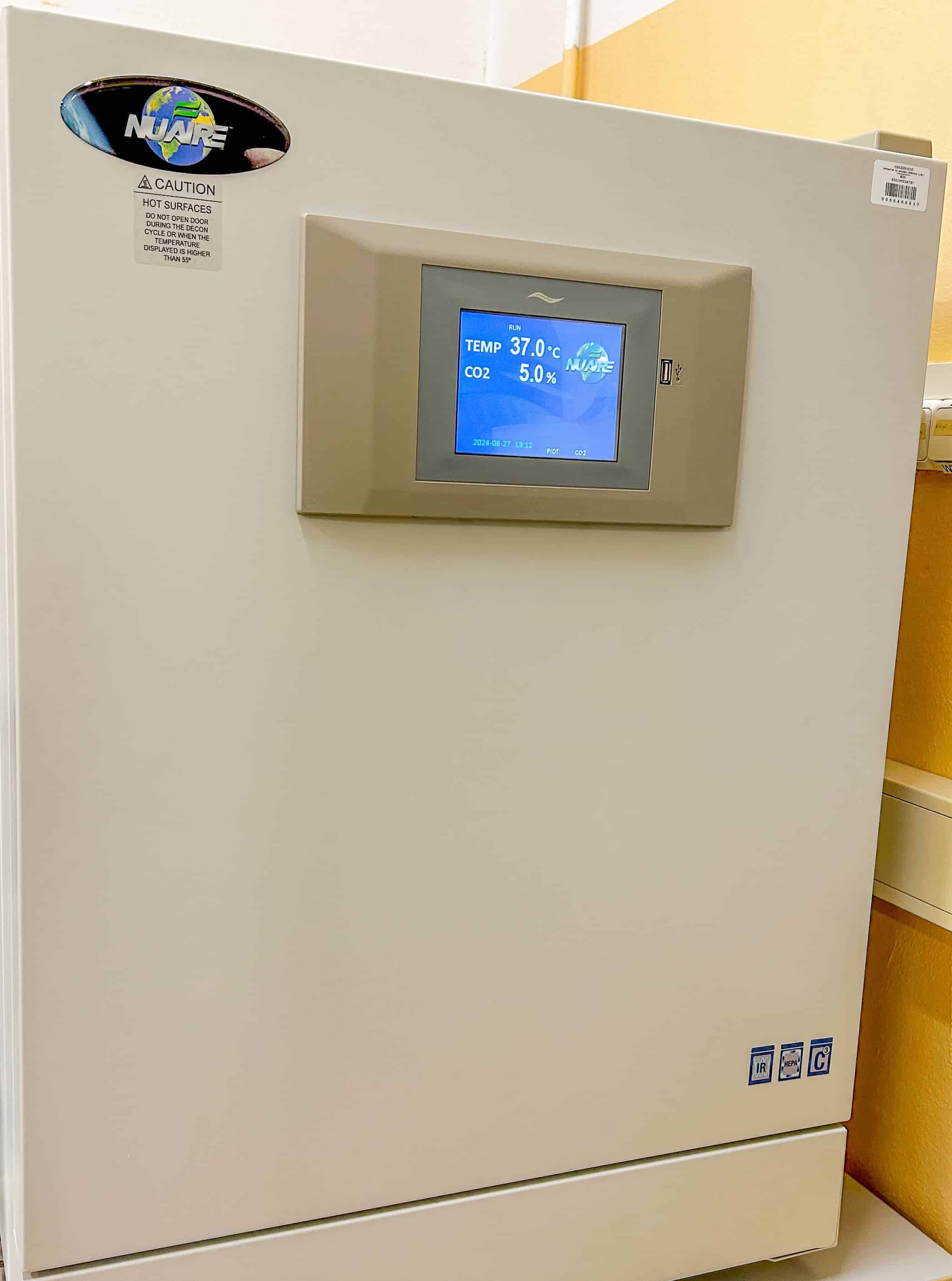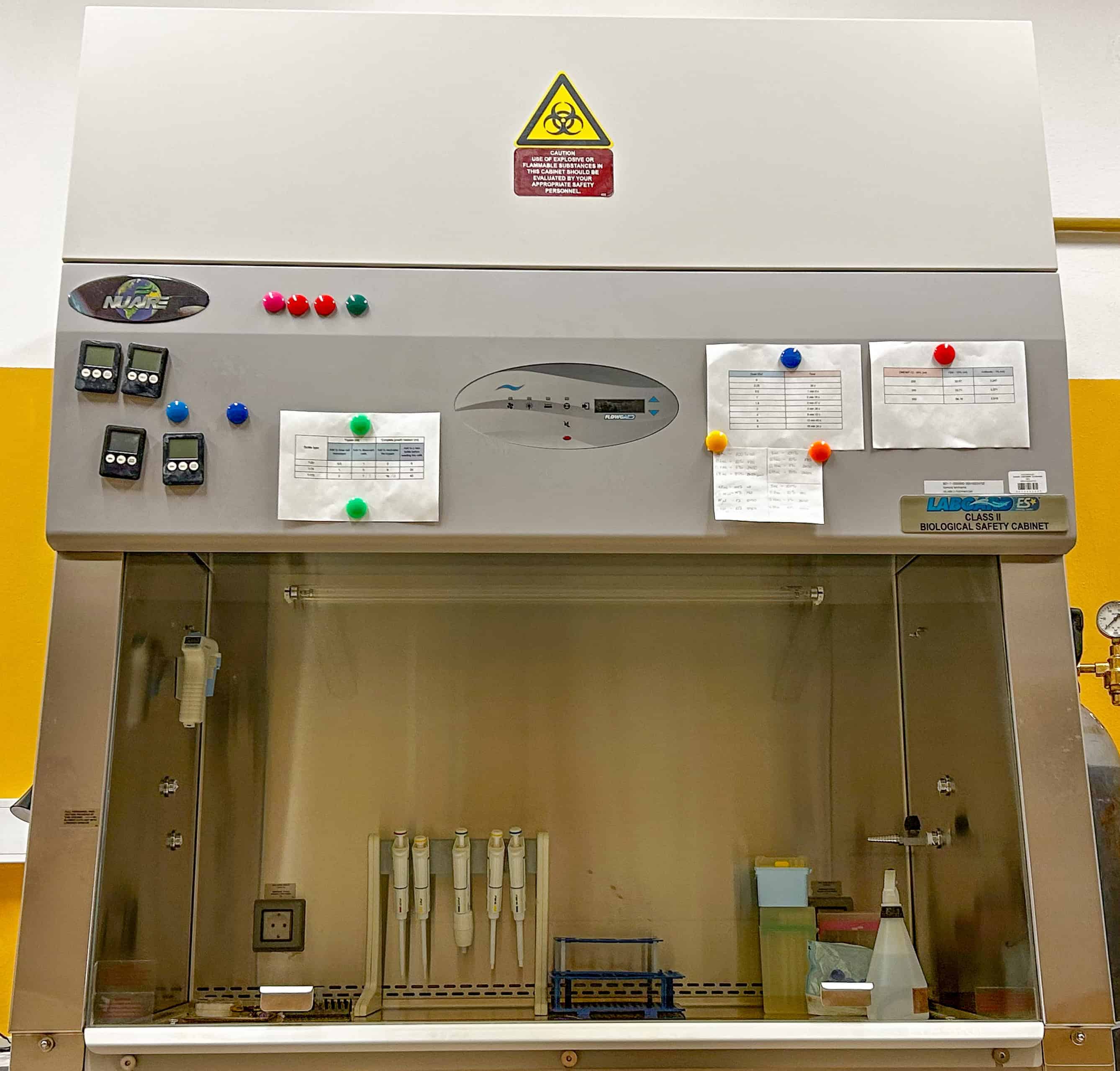Instrumentation
Delta Optical IB-100 LED Inverted Microscope
The Delta Optical IB-100 LED inverted microscope is utilized in the Laboratory for the observation of biological specimens under brightfield and phase contrast illumination. The system is equipped with an epifluorescence module comprising B, G, U, and V filter sets, as well as a full range of plan achromatic and phase contrast objectives. This system supports high-resolution imaging of both 2D and 3D cell cultures and is routinely employed in assays such as live/dead viability analysis and γ-H2AX histone foci detection.

Delta Optical IB-100 LED Inverted Microscope
Surface Source of 241Am
In the radiobiology laboratory, a surface radioactive source of americium-241 (241Am) is employed for the irradiation of glioblastoma cell cultures. The source has a diameter of 50 mm and an activity of 1.96 MBq. The active layer consists of a composite of pure gold powder and americium dioxide (AmO₂) in a 1:0.0425 mass ratio, encapsulated with a protective gold coating. During irradiation procedures, the source is affixed to the inner surface of a Petri dish lid, ensuring proximity to the cellular monolayer or 3D culture. To safeguard the radioactive material against mechanical damage and contamination, the source is additionally sealed with a 6 μm-thick Mylar film.

Surface Source of 241Am
NUAIRE CO₂ Incubator

NUAIRE CO₂ Incubator (model: NU-5710E)
The NUAIRE CO₂ incubator is a fundamental piece of equipment widely utilized in biological, biotechnological, and medical laboratories. It enables precise regulation of environmental parameters essential for in vitro experiments, particularly those involving the cultivation of mammalian, microbial, or plant cells. The incubator provides tightly controlled conditions for the following variables:
- Temperature: The incubator allows for accurate thermal regulation tailored to the specific requirements of a given experiment. Optimal temperature conditions depend on the type of cultured cells or microorganisms. In most cases, a temperature of approximately 37°C is maintained to mimic human physiological conditions.
- Humidity: To prevent cellular desiccation and to ensure a stable internal microenvironment, the incubator requires the continuous presence of water. This is typically achieved via a dedicated water reservoir (humidification pan) placed within the chamber, maintaining high relative humidity levels.
- Carbon Dioxide Concentration (CO₂): The incubator operates at a CO₂ concentration of 5%, which closely simulates the gaseous environment of mammalian tissues. This is particularly critical for the cultivation of eukaryotic cells, as CO₂ is integral to maintaining the pH stability of bicarbonate-buffered culture media.
Due to its ability to maintain physiologically relevant conditions, the incubator is employed in a range of applications, including:
- The cultivation of animal, plant, bacterial, and fungal cell cultures,
- The execution of biochemical reactions that require a controlled environment,
- Research related to cell-based therapies, drug testing, and chemical toxicity assessment.
Precise environmental control within the incubator is essential for ensuring reproducible cell growth, experimental reliability, and the integrity of downstream analyses.
NUAIRE Laminar Flow Cabinet

NUAIRE Laminar Flow Cabinet (model: NU-543-400S)
The NUAIRE laminar flow cabinet is a high-performance laboratory device engineered to maintain aseptic conditions during the handling of sensitive biological materials. It provides a sterile working environment through unidirectional airflow, effectively protecting both the samples and the operator from airborne contamination.
This unit is equipped with a HEPA filtration system (High-Efficiency Particulate Air). The filtered air flows uniformly across the work surface, creating an ISO Class 5 (Class 100) clean environment compliant with international cleanroom standards.
NUAIRE cabinets are specifically designed for:
- Aseptic manipulations, such as cell culture, media preparation, and sterile reagent handling.
- Molecular biology protocols involving RNA/DNA extraction or PCR setup.
- Pharmaceutical and biomedical workflows require contamination-free environments.
Operational safety and efficiency are supported by:
- An ergonomic design with reduced airflow turbulence.
- An alarm system indicates airflow deviations or filter saturation.
- Easy-to-clean stainless steel interior surfaces to minimize microbial adherence.
To ensure sterile operation, standard laboratory protocols should be followed:
- Disinfect all surfaces and instruments with 70% ethanol before use.
- Wear appropriate personal protective equipment (PPE), including sterile gloves, lab coats, and face masks.
- Avoid obstructing airflow by maintaining clear zones around filter vents.
The NUAIRE laminar flow cabinet is essential for ensuring experimental reproducibility, biological sample integrity, and compliance with biosafety standards in cell and molecular biology laboratories.
LUNA-II™ Automated Cell Counter
The laboratory is equipped with the LUNA-II™ Automated Cell Counter from Logos Biosystems, a precision instrument designed for high-accuracy, reproducible cell quantification under brightfield imaging. The system supports customizable counting protocols and enables rapid, user-friendly analysis.
A color-coded system aids in real-time verification of viability assays—viable cells are indicated in green, while non-viable cells appear in red. Results can be viewed directly on the instrument’s display and exported in the form of comprehensive image-based reports.
Cell viability is assessed using Trypan Blue, a vital dye that selectively penetrates cells with compromised plasma membranes. Live cells exclude the dye, remaining unstained, whereas dead cells take up the dye, resulting in cytoplasmic coloration. This differential staining facilitates the reliable quantification of viable versus non-viable cells.

